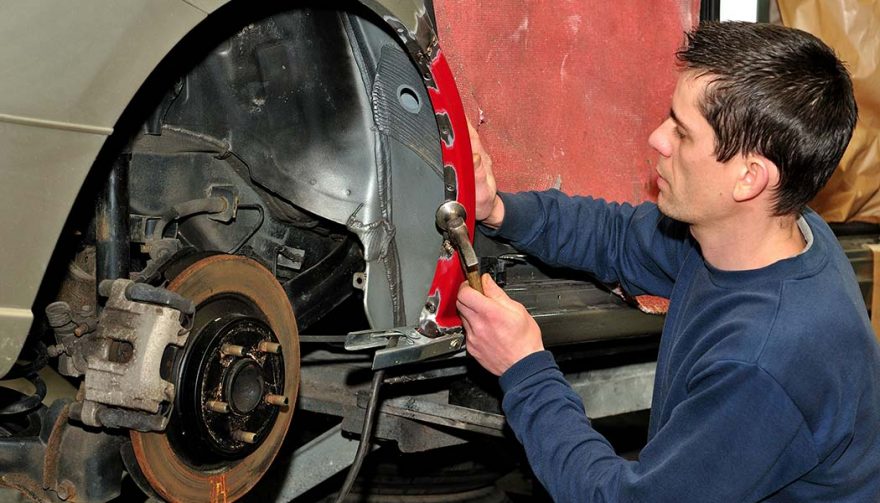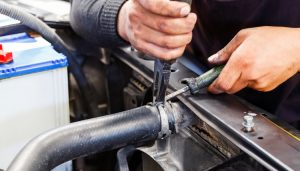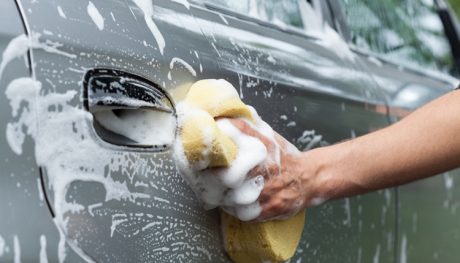
Use the right equipment if you plan on keeping safe during car maintenance
Keeping Safe While Working on Your Car: Tips and Tricks for DIYers
When you think about risks involving automobiles, chances are good your mind first leaps to auto accidents on the road. However, accidents can and do happen anywhere, including in your garage while you’re tinkering under the hood or changing the oil.
How to Stay Safe While You Work on Your Car
Whether you’re a seasoned pro doing your own vehicle maintenance, or just someone who’s bound and determined to go the DIY route with automotive work, it’s imperative that you stay safe while doing it. Here are some of the most important tips to ensure you can do just that.
Be Careful Getting It Off the Ground
Whether you’re doing your own tire rotation or changing out those rundown shocks, you have to get your car off the ground. It can be tempting to rely on the wrong tools here – your floor jack is more than capable of supporting one end of the car, right? And you can put the other end on blocks. That’s a very bad idea. All it takes is a little bit of movement and the front end can slide right off the jack, and those cinderblocks will turn to dust very quickly. If you’re under the car when it happens, there’s a very good chance you won’t live to talk about it.
Be careful when getting your car off the ground. Use the right jack for the job, certainly, but make sure you have strong jack stands as well. Jack stands are cheap, widely available, and strong enough to do the job without putting you in danger of becoming a human pancake.
At the risk of being redundant – always use a jack stand (or a set of stands). Avoid cinderblocks, bricks, chunks of wood and jacks.
Location, Location, Location
Yes, that’s the mantra for real estate, but DIY mechanics need to practice it as well, particularly when it comes to jacking up the car. You might be tempted to put your car on a jack in the front yard to change that tire, but that’s not a good idea. Unless you’re on concrete, you don’t have any business jacking up that car in the first place. Jacks will quickly sink into even hard-packed earth, and even into asphalt (as anyone who’s ever had to change a tire on the side of the road in the summertime can tell you).
Don’t think that using a board or even a cement block will be enough to save you, either. Wood can easily crack, particularly under the weight of your car’s front end. Cement blocks aren’t particularly famous for their durability, either. You need a solid concrete surface for this type of work.
Protect Yourself
You’ve got your car jacked up and safely on jack stands. You’ve got the wheels off, and you’re about to start working on those rear drum brakes. You remove the drum and are about to start your work when the spring shoots off – it hits you in the eye. Great, now you’re blinded (or at least seriously injured). One of the most important aspects of DIY auto maintenance (and one of the most frequently overlooked) is the right protective gear.
You should have at a minimum:
- Safety Glasses – Yeah, we know you hate them. We do too. Still, there’s no better way to protect those baby blues than by wearing a pair of these. They should be large enough that they completely cover your eye sockets, but they don’t have to be super bulky. You’ll find some options on the market that are almost stylish. Wear them.
- Close Fitting Clothing – No, wearing tight-fitting clothes probably isn’t your idea of fun when working on a car, but it’s important. Loose clothing can easily become wrapped around things (including moving engine parts). We’ve all heard those horror stories about guys and their ties, so don’t become a statistic.
- Burn Sleeves – One of the most common injuries when working on a car is a burn. Whether you’re changing the oil, replacing an oxygen sensor, or investigating that weird noise coming from your exhaust, things down there are HOT. A burn sleeve will protect your skin from the brunt of it.
Beware of Coolant
If you’re doing radiator work (or just working near the radiator), make sure that you wait until things have cooled off. Engine coolant gets very hot, and it becomes pressurized when the engine is running. Opening that cap too soon could completely cover you in scalding coolant, which is definitely no fun (and could cause serious burns). If you’re working on or around the radiator, wait until things have cooled down and the pressure has dropped to get to work.
Vent It
You’d be surprised at the number of DIY mechanics who manage to close their garage door with a running engine inside. That’s a recipe for disaster (and possibly death through asphyxiation). If you’re working on a running car inside your garage, make sure the door is open. To be extra safe, attach an exhaust hose from to the muffler tip and run it well outside. The ventilation tip also applies to other automotive work, from painting to using cleaning chemicals. Always work in a well-ventilated area.
Have a Fire Extinguisher
Sure, it might set you back $20 or $30, but compared to the cost of a car, or even your home, that’s an infinitesimal price to pay. Remember that almost every fluid you deal with in automotive service is flammable. That applies to gas, certainly, but it also applies to engine oil, gear dope, paint, cleaning chemicals and more. Combine that with the chance of a stray spark igniting a pile of dirty grease rags in the corner, or an improperly secured fuel line spraying everywhere and you can see the importance of this safety tip.
Working on your own car can be empowering. It can help you save money and can even be a passion. However, it’s essential that you’re safe while doing it.





